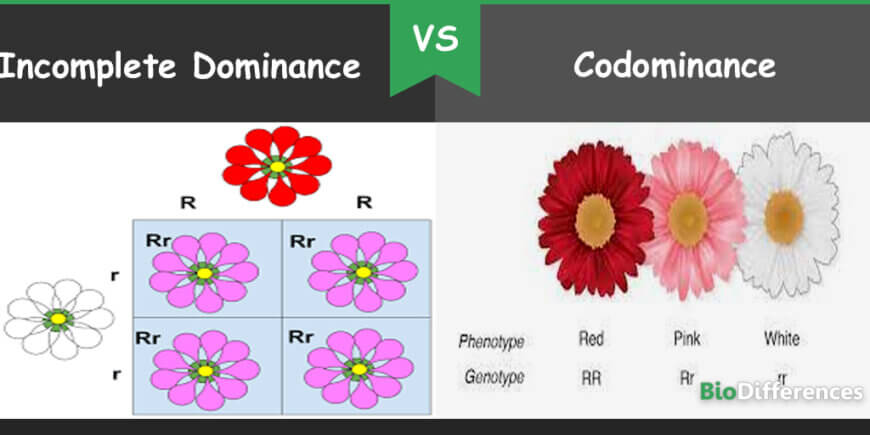Genes are the segments of the DNA located on the chromosomes. These genes contain genetic information that is transferred from one generation to the other generation. Gregor Mendel studied genetics and proposed that the traits are inherited by the transfer of genes from the parents to their offspring. There are usually two alleles for each trait inherited by the animal cells. These paired alleles can be heterozygous or may be homozygous for a given trait. Heterozygous pair has different alleles, whereas homozygous pair has identical allele. When any two alleles are expressed in an individual, it may be by incomplete dominance or codominance.

When one allele for a particular trait does not completely dominate over the other allele, this is called incomplete dominance. The phenotype produced in incomplete dominance is the complete mixture of both dominant and recessive alleles. On the other hand, in co-dominance, both the alleles for a particular trait are equally expressed. As a result, the phenotype will show both the characters equally of both participating alleles.
In a single population, there are often many different alleles. In an organism’s genotype, a set of alleles still determines its phenotype. Incomplete dominance and codominance differ from each other based on the pattern of gene expression.
Contents
Comparison Chart
| Basis for Comparison | Incomplete dominance | Phenotype |
| Definition | Incomplete dominance is when a dominant allele or a gene does not completely mask the effects of a recessive allele and the organism’s resulting phenotype shows a blending of both alleles. | Codominance is the condition in which two alleles of for a character are equally expressed with neither being recessive or dominant. |
| Dominance of the allele | Neither of both alleles will be dominant | Both the alleles are fully dominant |
| Effect | One allele is more expressed and dominant | Both the alleles show their equal effects |
| Example | Snapdragon flower, Mirabilis jalapa | Roan character in cattle, AB blood group in humans |
What is Incomplete dominance?
Correns discovered incomplete dominance. In this type of dominance, one allele for a specific trait is not able to express completely over its paired allele. This is the reason of its other name intermediate inheritance, in which the produced phenotype is the third type. In incomplete dominance, there is a combination of the phenotype of both the participating alleles. It is also called as semi dominance or partial dominance.
Examples
In snapdragon flower, the color will be homozygous for either white or red. When the red homozygous flower is matching with the white homozygous flower, the result will be a pink color flower. This is the type of incomplete dominance.
Height and hair color in offspring are two other examples of incomplete dominance in humans. Offspring will not have the same height or hair color as one of their parents but will often have a mixture of the two parents’ phenotypes.
What is Co-Dominance?
In co-dominance, both the characters are equally expressed. Thus, the resultant phenotype will represent more than one character. Co-dominance is similar with the incomplete dominance in which both the alleles are expressed in heterozygotes.
Examples
Sickle cell disorder is a common example of codominance. It is the abnormal condition of the hemoglobin in which red blood cells are formed of sickle shape. In normal conditions, the shape of the red blood cells is disc-like and biconcave, having the protein called hemoglobin. This hemoglobin plays a major role in transporting oxygen to the cells and other parts of the body. But certain mutations in the hemoglobin gene produce sickle cells.
The sickle blood cells are stuck to the blood vessels preventing the normal flow of the blood. The individuals having this disease are the homozygous recessive for the sickle cell hemoglobin gene.
Another example of codominance is the AB blood group. If a person with A-type blood group mates with the person with B type blood group, then there is a possibility of their offspring having an AB blood group where both the phenotypes are fully expressed.
Key Differences
- Incomplete dominance is the state in which neither of the alleles is dominant; instead, display a new trait by mixing the allele, whereas codominance is the condition in which both the alleles of a gene are dominant, and traits are equally expressed.
- Incomplete dominance can be seen in Mirabilis Jalapa, whereas Codominance can be seen in Roan character in cattle.
- In incomplete dominance, a new phenotype is produced by the hybrid
Key Similarities
- In both incomplete dominance and codominance, both alleles for a trait are dominant.
Conclusion
In conclusion, incomplete dominance and codominance are studied in genetics. The study of genetics is challenging but understandable due to many contributions.